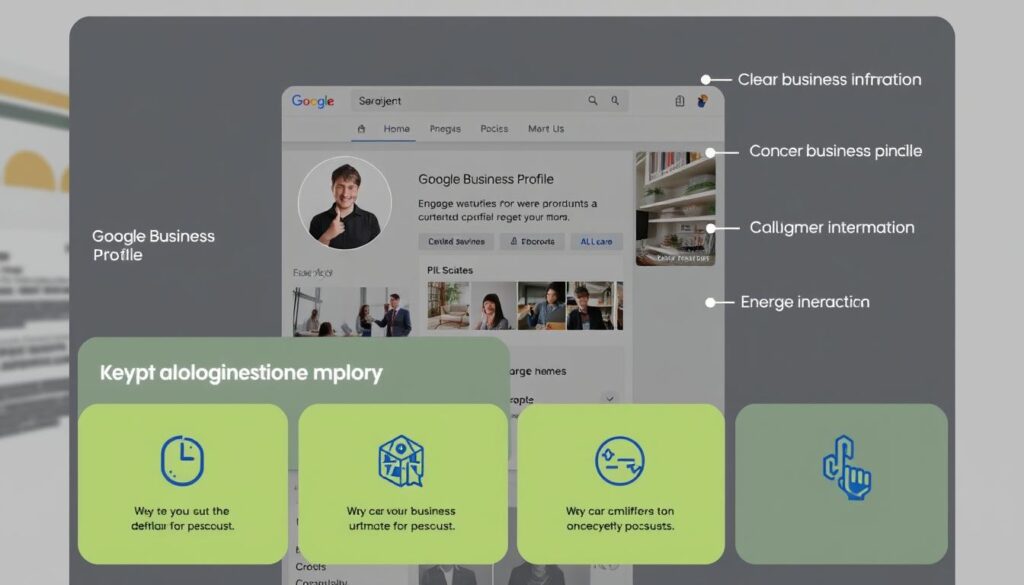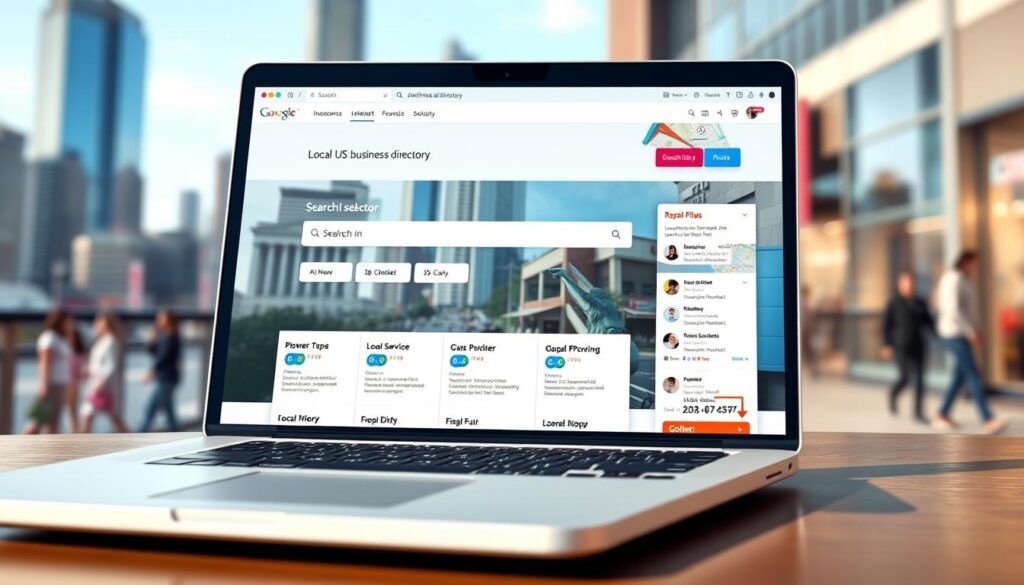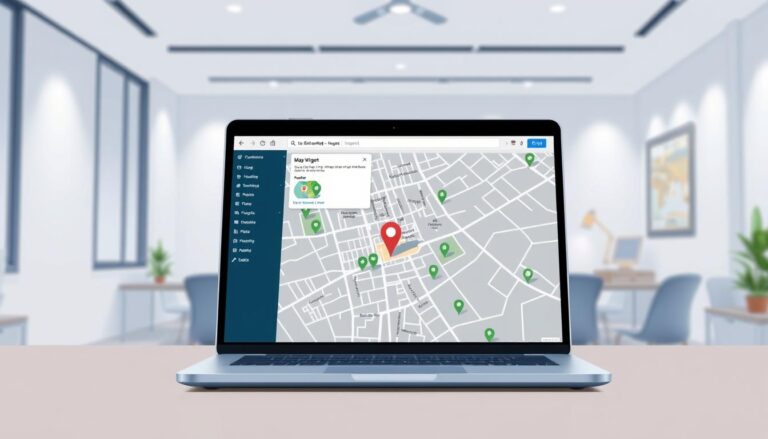As a business owner in the US, having a strong online presence is crucial for attracting customers and staying ahead of the competition. In today’s digital landscape, local SEO plays a vital role in ensuring your business is visible to potential customers searching for products or services in your area.
If you’re not optimizing your website for local search, you’re likely missing out on a significant opportunity to drive sales and grow your business. I will explore the importance of SEO for US businesses and provide insights into the strategies you can use to boost your visibility in search engine results.
By understanding the nuances of local search and implementing effective SEO strategies, you can increase your online presence, drive more traffic to your website, and ultimately, attract more customers.
Key Takeaways
- Understanding the importance of local SEO for US businesses
- The differences between local search and traditional search
- Strategies to boost local search visibility
- The role of ongoing attention and adaptation in local SEO
- Practical steps to optimize your website for local search
Understanding Local Search Algorithms and Ranking Factors
Understanding how local search algorithms work is crucial for businesses aiming to improve their visibility in search results. As I delve into the intricacies of local search, it becomes clear that Google’s algorithm is designed to provide the most relevant results to users.

How Google Determines Local Rankings
Google’s local search algorithm is a complex system that evaluates numerous factors to rank businesses. Unlike standard search algorithms, local search gives significant weight to the business’s proximity to the searcher, its relevance to the search query, and its overall prominence. This means that local SEO strategies must be tailored to these unique ranking factors.
To determine local rankings, Google gathers information from various sources, including business listings, reviews, and the business’s own website. This information is then analyzed to assess the business’s relevance to the search query, its distance from the searcher’s location, and its overall prominence in the community.
Key Local Ranking Signals: Relevance, Distance, and Prominence
The three primary ranking signals for local search are relevance, distance, and prominence. Relevance refers to how well a business matches what someone is searching for. For instance, if a user searches for “coffee shops,” a coffee shop is more relevant than a bookstore. Distance considers how far each potential search result is from the location term used in a search. Prominence refers to how well-known a business is, both online and offline.
- Relevance is crucial as it directly impacts how well a business matches the user’s search query.
- Distance is also a key factor, as users typically prefer businesses that are closer to their location.
- Prominence plays a significant role, as well-known businesses are generally given more weight in search results.
By understanding and optimizing for these ranking signals, businesses can improve their visibility in local search results, driving more traffic and sales. Effective SEO strategies that focus on these areas can significantly enhance a business’s online presence.
How to Improve Local Search Rankings for US Businesses
A well-planned local SEO approach can significantly enhance your business’s local search rankings. Before diving into improvements, it’s essential to understand your current standing. As with any strategy, assessing your current position helps you make informed decisions rather than blindly tweaking potentially effective elements.

Conducting a Local SEO Audit
Performing a comprehensive local SEO audit is the first step towards improving your local search presence. This involves evaluating your website’s visibility, local search rankings, and overall online presence. A local SEO audit helps identify strengths, weaknesses, and opportunities for improvement. It includes analyzing your Google Business Profile, local citations, and website content to ensure it is optimized for local searches.
To conduct a thorough audit, I’ll outline a step-by-step approach that includes:
- Evaluating your current local search visibility
- Assessing your Google Business Profile completeness and accuracy
- Analyzing local citations and their consistency
- Reviewing your website’s content for local SEO relevance
Setting Realistic Goals and Expectations
After conducting the audit, it’s crucial to set realistic goals based on your industry, competition, and current positioning in search results. This involves understanding the local SEO landscape and establishing achievable targets for improvement. By setting clear goals, you can focus your efforts on the most impactful strategies.
Measuring Local SEO Success
Measuring local SEO success involves tracking key metrics that matter most for your business. These include visibility in the local pack, click-through rates, and conversion metrics specific to local businesses. By monitoring these metrics, you can assess the effectiveness of your local SEO strategy and make necessary adjustments to improve your search rankings and overall visibility.
Optimizing Your Google Business Profile

A well-optimized Google Business Profile is the cornerstone of a successful local SEO strategy. Your Google Business Profile (GBP) is often the first impression potential customers have of your business, making it crucial to get it right.
Claiming and Verifying Your Business
To start optimizing your GBP, you need to claim and verify your business. This process involves confirming your business’s existence and ensuring it’s listed accurately on Google. Verification is a critical step as it helps Google trust your business listing, making it more likely to appear in local search results. I recommend following Google’s verification process closely to avoid common issues.
Completing All Profile Sections
Completing every section of your Google Business Profile is vital. This includes crafting a compelling business description, selecting the right categories, and providing accurate contact information. By filling out all sections, you’re giving Google a comprehensive understanding of your business, which can improve your visibility in relevant searches. Make sure to incorporate relevant keywords naturally into your description to enhance your local SEO.
Adding High-Quality Photos and Posts
High-quality photos and regular posts can significantly enhance your Google Business Profile’s engagement and conversion potential. Photos give potential customers a visual representation of your business, products, or services. Posts allow you to share updates, promotions, or events, keeping your audience engaged. I suggest using high-quality images and creating a content calendar to maintain consistency.
Setting Accurate Business Hours and Service Areas
Accurate business hours and properly defined service areas are critical, especially for businesses serving customers at multiple locations or providing services at customer locations. Ensuring your business hours are up-to-date helps manage customer expectations, while correctly defining your service areas helps Google understand where you operate, improving your local search visibility.
Building a Review Management Strategy
Reviews play a pivotal role in local SEO, making a review management strategy indispensable. With 77% of consumers reading reviews before making a decision, it’s clear that reviews significantly impact both local search rankings and consumer choice.
Encouraging Customers to Leave Reviews
To boost your review count, focus on delivering exceptional customer service and then politely ask satisfied customers to share their experiences. This can be done through email campaigns, in-store promotions, or after-service follow-ups, ensuring you’re compliant with each review platform’s guidelines.
Responding to Positive and Negative Reviews
Responding to all reviews, both positive and negative, demonstrates your business’s commitment to customer satisfaction and improves your online reputation. For positive reviews, a simple “thank you” can suffice, while negative reviews require a more nuanced response to address customer concerns and show empathy.
Leveraging Reviews for Business Improvement
Reviews are a valuable source of feedback. By analyzing them, you can identify recurring issues or areas for improvement. This insight allows you to make informed decisions, enhancing your products, services, and overall customer experience, thereby fostering trust and loyalty.
By implementing a comprehensive review management strategy, you not only enhance your local SEO but also build a stronger, more trustworthy brand. This involves regularly monitoring reviews across multiple platforms, responding appropriately, and using the feedback to drive business improvements.
Creating Effective Local Landing Pages

Local landing pages play a crucial role in enhancing the online visibility of businesses with multiple physical locations or service areas. A well-structured local landing page can provide users with relevant information about a specific location, making it easier for them to find what they’re looking for.
Structuring Location-Specific Pages
When structuring location-specific pages, it’s essential to include essential elements such as the business’s name, address, and phone number (NAP), as well as unique content that highlights the specific location. This can include maps, customer testimonials, and photos that showcase the location.
Incorporating Local Keywords and Content
Incorporating local keywords and content is vital for signaling relevance to both search engines and local customers. I recommend using local landmarks, community references, and keywords that are relevant to the specific location to improve the page’s visibility in local search results.
Optimizing for Mobile Users
With the majority of local searches being conducted on mobile devices, optimizing local landing pages for mobile users is crucial. This includes ensuring that the page is mobile-friendly, loads quickly, and has a responsive design that adapts to different screen sizes.
By following these best practices, businesses can create effective local landing pages that improve their online visibility, drive more local traffic to their websites, and attract relevant customers.
Implementing Local Business Schema Markup

By implementing local business schema markup, you can provide search engines with the structured data they need to understand your website’s content. This can lead to improved search engine rankings and increased visibility for your local business.
Understanding Schema Types for Local Businesses
Schema markup is not a one-size-fits-all solution. For local businesses, there are specific schema types that are particularly relevant. These include LocalBusiness schema and Review schema. LocalBusiness schema helps search engines understand your business’s name, address, and hours of operation, while Review schema can enhance your website’s appearance in search results with rich snippets.
Adding Schema to Your Website
Adding schema markup to your website can seem daunting, but it’s a manageable task. You can start by identifying the most relevant schema types for your business and then use tools like Google’s Structured Data Markup Helper to generate the necessary code. Once you’ve added the schema markup to your website, it’s essential to test it using tools like Google’s Rich Results Test to ensure that it’s working correctly.
Properly implemented schema markup can have a significant impact on your website’s SEO and local SEO. By providing search engines with the structured data they need, you can improve your website’s visibility in search results and drive more traffic to your site.
Establishing NAP Consistency Across the Web
For US businesses, having a consistent Name, Address, and Phone Number (NAP) across the internet is a critical factor in local search engine optimization. This consistency is fundamental to how search engines evaluate a business’s credibility and relevance in local search results.
Managing Business Listings and Citations is a crucial step in achieving NAP consistency. This involves listing your business in major directories, industry-specific platforms, and social media profiles. To effectively manage these listings, it’s essential to identify the most authoritative and relevant directories for your business. For instance, utilizing US business directories can significantly enhance your online presence. I recommend creating a comprehensive list of potential directories and platforms where your business should be listed.
Managing Business Listings and Citations
To manage business listings effectively, start by identifying major directories and industry-specific platforms. For example, general citation sites and location-specific directories can be valuable. When building citations, ensure your NAP is consistent throughout. This consistency is vital for search engines to trust your business’s online presence.
- Identify authoritative directories for your business.
- List your business in major and industry-specific directories.
- Ensure NAP consistency across all listings.
Auditing and Fixing Inconsistent Information
Auditing your business listings for inconsistencies is a critical step. This process involves checking your NAP across various directories and platforms, identifying any discrepancies, and correcting them. Prioritize fixes based on the impact of the directory on your business’s visibility. Regular audits will help maintain consistency over time, especially when changes occur, such as moving locations or changing phone numbers.
To efficiently update and maintain consistent business information, leveraging data aggregators can be highly effective. Data aggregators distribute your business information across multiple directories, ensuring consistency and saving time. Understanding the role of these aggregators in the US citation ecosystem can significantly enhance your local SEO efforts.
By focusing on NAP consistency, managing business listings, and leveraging data aggregators, businesses can improve their local SEO, enhancing their online visibility and credibility.
Developing a Local Link Building Strategy
Building a robust local link building strategy is crucial for enhancing your business’s online visibility in local search results. Links have been a cornerstone of search engine optimization for years, and while their importance as a ranking signal may have evolved, they remain valuable for passing authority and driving referral traffic.
For local businesses, the focus should be on acquiring links from locally relevant sources rather than just pursuing high-authority sites. This approach not only boosts your website’s authority but also increases your visibility within your community.
Identifying Local Link Opportunities
To start, it’s essential to identify high-value local link opportunities that are specific to your business’s location and industry. This can include local news sites, business associations, and community resources. Researching and listing potential link sources is a critical first step.
- Local news sites and blogs
- Industry-specific directories
- Community event calendars
- Local business associations
Engaging with Community Organizations
Engaging with local community organizations is a practical way to build relationships that can lead to valuable local links. By participating in or sponsoring local events, you can increase your business’s visibility and earn links from reputable local sources.
Some effective strategies include:
- Partnering with local charities
- Sponsoring community events
- Participating in local trade associations
Leveraging Local Partnerships and Sponsorships
Leveraging local partnerships and sponsorships is another effective way to generate quality links while enhancing your business’s local reputation. By collaborating with other local businesses or organizations, you can create mutually beneficial opportunities that drive both link equity and community engagement.
Examples include co-hosting events, collaborating on content, or simply cross-promoting each other’s services.
Improving Website Performance for Local SEO
In today’s digital landscape, a fast and user-friendly website is essential for local search visibility. Your website’s performance plays a crucial role in determining your local search rankings and user experience. As Google continues to emphasize the importance of Core Web Vitals, it’s vital to optimize your website accordingly.
Optimizing Core Web Vitals
Core Web Vitals are a set of metrics that Google uses to assess how well users experience your site. To optimize Core Web Vitals, focus on improving page speed, interactivity, and visual stability. This can be achieved by optimizing images, leveraging browser caching, and minimizing CSS and JavaScript files. By doing so, you’ll not only improve your search rankings but also provide a better user experience for your visitors.
Enhancing Mobile Experience
With the majority of local searches happening on mobile devices, having a mobile-friendly website is no longer optional. To enhance the mobile experience, ensure that your website is responsive, loads quickly, and has easy-to-click buttons and menus. You can test your website’s mobile usability using Google’s Mobile-Friendly Test tool and make necessary adjustments to improve the overall user experience.
Creating Localized Content That Converts
Creating content that resonates with your local audience is crucial for converting visitors into customers. To achieve this, focus on creating content that’s relevant to your local community, such as blog posts about local events or news. Use location-specific keywords naturally throughout your content, and ensure that your website’s content is up-to-date and accurate. By doing so, you’ll not only improve your search visibility but also build trust with your local audience.
Conclusion
With the majority of consumers turning to Google to find local products and services, a comprehensive local SEO strategy is no longer a luxury, but a necessity. As we’ve discussed throughout this article, optimizing your US business for better local search results involves multiple interconnected techniques.
To recap, we’ve covered key strategies such as optimizing your Google Business Profile, building a review management strategy, creating effective local landing pages, implementing local business schema markup, establishing NAP consistency, developing a local link building strategy, and improving website performance for local SEO. Each of these elements plays a crucial role in enhancing your online visibility and driving high-quality traffic to your business.
A holistic approach to local SEO is essential, as it addresses all aspects of your online presence. By doing so, you’ll not only improve your search rankings but also provide a better user experience for your customers. To get started, I recommend creating a prioritized action plan based on the strategies discussed, focusing on the most impactful efforts first.
It’s also important to remember that local SEO is an ongoing process. Staying current with algorithm updates and evolving best practices is crucial to maintaining and improving your rankings over time. By committing to a comprehensive local SEO strategy, businesses can reap significant rewards, including increased online visibility, more customers, and ultimately, a higher return on investment.
In conclusion, by implementing these strategies and staying committed to your local SEO efforts, you’ll be well on your way to dominating the search results and attracting the customers you need to grow your business.










